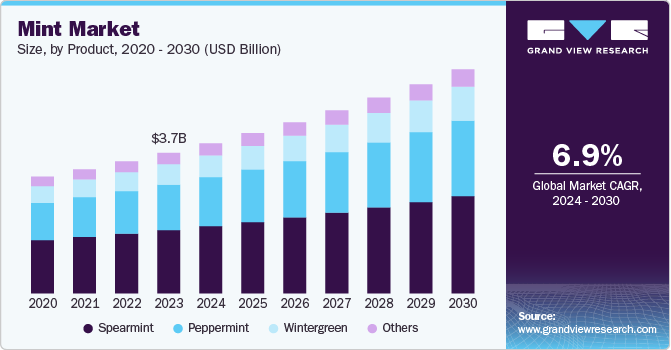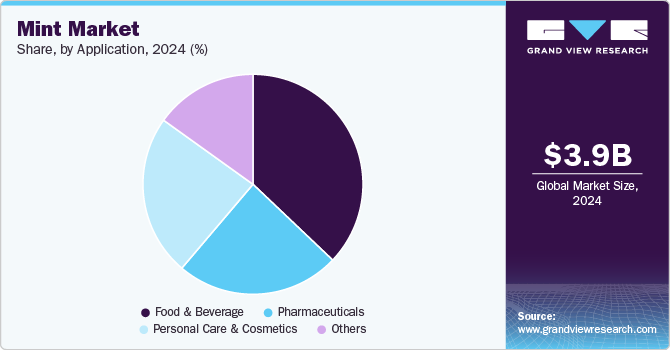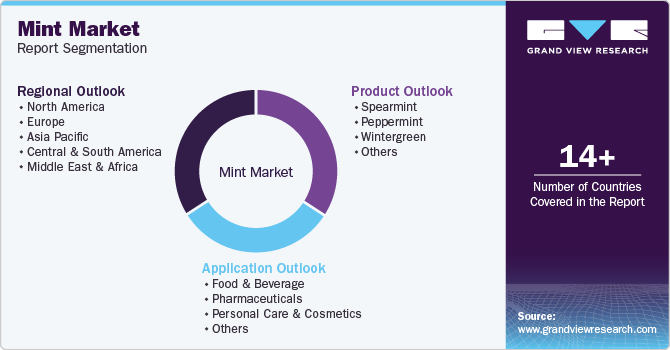- Home
- »
- Consumer F&B
- »
-
Mint Market Size, Share And Growth Analysis Report, 2030GVR Report cover
![Mint Market Size, Share & Trends Report]()
Mint Market Size, Share & Trends Analysis Report By Product (Spearmint, Peppermint, Wintergreen), By Application, By Region, And Segment Forecasts, 2024 - 2030
- Report ID: GVR-4-68040-483-5
- Number of Report Pages: 80
- Format: PDF, Horizon Databook
- Historical Range: 2018 - 2023
- Forecast Period: 2024 - 2030
- Industry: Consumer Goods
Mint Market Size & Trends
The global mint market was estimated at USD 3.72 billion in 2023 and is expected to grow at a CAGR of 6.9% from 2024 to 2030. The growth of the market, particularly for peppermint oil, is driven by several key factors that reflect changing consumer preferences and industry trends. One of the primary drivers is the increasing demand for natural and organic products across various sectors, including food, cosmetics, and pharmaceuticals. As consumers become more health-conscious, there is a noticeable shift away from synthetic ingredients towards plant-based alternatives, which enhances the appeal of peppermint oil due to its natural flavor and therapeutic properties. Additionally, the rising popularity of aromatherapy has significantly contributed to the market's expansion, as peppermint oil is favored for its refreshing aroma and potential health benefits, such as stress relief and improved digestion.

Another important factor propelling market growth is the growing application of peppermint oil in personal care products. Its long shelf life and stability under various conditions make it an ideal ingredient for skin care formulations like moisturizers and anti-acne products. Furthermore, the increasing disposable income and standard of living in many regions have led to higher spending on premium personal care items, further driving demand for peppermint oil. The food and beverage industry also plays a crucial role, with peppermint being widely used as a flavoring agent in candies, gums, and beverages.
Moreover, advancements in extraction technologies and increased investment in research and development are enabling manufacturers to enhance product quality and develop innovative applications for peppermint oil. The rise of e-commerce platforms, a key player in the market, has significantly facilitated easier access to these products for consumers worldwide. However, challenges such as limited raw material supply and stringent quality standards may impact growth; nonetheless, government support for natural ingredient adoption is expected to create lucrative opportunities for market players. The mint market is poised for significant growth as it aligns with contemporary consumer trends favoring health, wellness, and sustainability.
Additionally, the growing popularity of health-oriented products has fueled demand for mint-flavored items perceived as having digestive benefits. Peppermint is often associated with alleviating symptoms of indigestion and nausea, making it a sought-after ingredient in functional foods and beverages. The F&B sector's shift towards healthier options, including sugar-free and low-calorie products, has further propelled the growth of mint consumption. Manufacturers are responding to this trend by developing innovative mint-based products that cater to health-conscious consumers.
The mint market faces several restraints that could hinder its growth and expansion in the coming years. One significant challenge is the increasing consumer concerns regarding sugar content, artificial sweeteners, and food colors in mint products. As health consciousness rises, consumers are becoming more discerning about the ingredients in their food, leading to a demand for cleaner labels and healthier options. This shift requires manufacturers to reformulate products to meet these expectations, which can be costly and complex.
Additionally, the potential health risks associated with excessive mint consumption, such as digestive issues or allergic reactions, may deter some consumers from using mint products regularly. This perception can limit market growth as consumers weigh the benefits against potential side effects. Overall, while the mint market has significant growth potential driven by health trends and product innovation, industry players must navigate these restraints carefully to sustain momentum.
Product Insights
Spearmint was the most consumed mint, with revenue exceeding USD 1.68 billion in 2023. One of the primary drivers for the growth of this segment is the increasing consumer awareness of the health benefits associated with spearmint oil, particularly its digestive and respiratory properties. This awareness fuels demand for spearmint in various applications, including pharmaceuticals and food products. Additionally, the rising trend towards natural and organic products has significantly boosted the demand for spearmint oil as consumers seek chemical-free alternatives in their personal care and home products.
The versatility of spearmint oil also contributes to its growth, as it is widely used in culinary applications due to its strong aromatic qualities. Its incorporation into food and beverages, such as candies, baked goods, and refreshing drinks, enhances flavor profiles while appealing to health-conscious consumers. Moreover, the growing popularity of aromatherapy has led to increased usage of spearmint oil for its calming effects, helping to relieve stress and fatigue.
The peppermint market segment is expected to grow at a CAGR of 7.4% from 2024 to 2030, primarily due to its increasing application in pharmaceuticals and cosmetics. Peppermint has a significantly higher concentration of menthol, making it ideally suited for applications like personal care and fragrances. The rising popularity of aromatherapy substantially contributes to the market's expansion, as peppermint oil is favored for its refreshing aroma and potential health benefits, such as stress relief and improved digestion.
Peppermint oil is valued for its analgesic properties, making it a popular ingredient in topical formulations for pain relief. Over-the-counter products are often used for headaches, muscle pain, and joint discomfort. The cooling sensation provided by menthol, a key component of peppermint oil, enhances its appeal in topical analgesics and other pharmaceutical applications. Another important factor driving market growth is the recognition of peppermint oil's effectiveness in managing gastrointestinal disorders, particularly irritable bowel syndrome (IBS). Clinical studies have shown that peppermint oil can alleviate symptoms such as abdominal pain, bloating, and flatulence due to its antispasmodic properties, which relax smooth muscles in the gastrointestinal tract. This therapeutic potential has led to a growing interest among healthcare providers in incorporating peppermint oil into treatment regimens for digestive issues.
Wintergreen mint is another form of mint extensively used in the personal care sector and is expected to grow at a CAGR of 7.6% over the forecast period. Wintergreen oil, known for its refreshing aroma and soothing effects, is increasingly favored by consumers seeking products free from synthetic chemicals. This trend aligns with the broader movement towards clean-label formulations, where consumers prioritize transparency and natural sourcing. Another significant driver is wintergreen oil's multifunctional benefits for skin care. Its natural astringent properties make it an excellent addition to toners and cleansers, helping to tighten pores and promote a clearer complexion. Additionally, its cooling sensation relieves irritated skin, making it a popular ingredient in after-sun products and creams designed for sensitive or inflamed skin. The oil's potential antibacterial properties also contribute to its appeal in acne treatments, as it can help reduce breakouts and maintain clear skin.
Application Insights
Food & beverage was the most extensive application of mint with market revenue of USD 1.38 billion in 2023. Mint has become a popular ingredient in the food and beverage industry due to its refreshing flavor, health benefits, and versatility. One of the key drivers is its distinct cooling sensation, which makes it an attractive flavor in products like beverages, chewing gum, and candies. Consumers are drawn to mint's ability to refresh and cleanse the palate, while its natural, mild taste appeals to a wide demographic.
Additionally, mint is associated with various health benefits, such as aiding digestion and providing antioxidant properties, which further enhances its use in wellness-focused products like teas and functional beverages. As consumers increasingly seek natural and organic ingredients, mint fits well into clean-label and plant-based trends, making it a go-to ingredient for brands looking to offer health-conscious options. Mint’s versatility also plays a crucial role, as it can be incorporated into a wide range of products, including ice creams, chocolates, cocktails, and herbal teas, ensuring its presence across multiple categories. This adaptability, combined with its natural appeal and health associations, continues to drive the demand for mint in the food and beverage industry.
Mint is widely used in the pharmaceutical industry due to its medicinal and therapeutic properties, particularly its ability to aid digestion and relieve gastrointestinal discomfort. Peppermint oil, rich in menthol, is a critical ingredient in products that treat indigestion, bloating, and irritable bowel syndrome (IBS), providing soothing relief. Another significant driver is mint’s analgesic properties, as menthol effectively alleviates pain and provides a cooling sensation when applied topically, making it popular in creams, ointments, and balms for muscle aches and joint pain.

Mint’s antimicrobial and anti-inflammatory properties also contribute to its use in products like lozenges, cough syrups, and oral hygiene products, where it helps to reduce irritation, soothe sore throats, and combat bacteria. Additionally, as consumer demand for natural and plant-based remedies grows, mint’s natural origin and widespread recognition as a safe, effective ingredient drive its continued use in various pharmaceutical formulations.
The growth of the peppermint market in the personal care industry is influenced by several key drivers that highlight its therapeutic properties and versatility. One of the primary drivers is the increasing consumer demand for natural and organic ingredients in personal care products. As consumers become more health-conscious and seek products free from synthetic chemicals, peppermint oil is increasingly favored for its natural origin and associated benefits, such as soothing skin irritations and refreshing scents.
Moreover, advancements in extraction technologies have improved the quality and efficacy of peppermint oil, making it more appealing to manufacturers looking to create high-quality personal care items. Expanding e-commerce platforms has also facilitated greater access to these products, allowing consumers to explore new offerings conveniently.
Regional Insights
Asia Pacific was the largest market for mint, with a revenue of USD 1.57 billion in 2023. Regional sales are expected to grow at a CAGR of 7.3% from 2024 to 2030. One of the primary drivers is the increasing consumer awareness of the health benefits associated with mint, particularly in countries like China and India, where mint is traditionally used for its medicinal properties. As people become more health-conscious, there is a rising demand for mint in various forms, including sugar-free confectionery products, which cater to this health trend.
The robust growth in end-use industries such as food and beverages, cosmetics, and pharmaceuticals significantly contributes to the market expansion. Mint is widely utilized in culinary applications, enhancing flavors in various dishes and beverages, leading to increased consumption. The growing popularity of mint-flavored products, including candies and drinks, is particularly notable among younger consumers who are adopting Western dietary habits.
North America Mint Market Trends
The North America mint market is expected to grow at a CAGR of 6.5% over the forecast period. There is a strong cultural emphasis on oral hygiene and fresh breath in North America. Consumers are increasingly aware of the importance of maintaining oral health, leading to heightened demand for mint products, particularly breath mints, and chewing gum. This trend is supported by educational campaigns promoting dental health, which emphasize the link between oral hygiene and overall well-being.
U.S. Mint Market Trends
The U.S. mint market is predominantly driven by its convenience and portability, making it a preferred choice. Busy lifestyles have led to an increased reliance on on-the-go solutions, with mint products providing an easy way to maintain freshness and oral care. The strong retail infrastructure in the U.S. facilitates the widespread availability of mint products through supermarkets, convenience stores, pharmacies, and online channels. This accessibility ensures that consumers can easily find and purchase their preferred mint products, further driving demand.
Key Mint Company Insights
The competitive landscape of the mint market is characterized by a diverse range of players, each contributing to the industry's growth and evolution. Major companies in this sector include well-established firms such as International Flavors & Fragrances Inc. and Young Living Essential Oils. These companies are recognized for their extensive product portfolios and strong market presence, which enable them to cater to various applications, including food and beverages, personal care, and pharmaceuticals.
Key Mint Companies:
The following are the leading companies in the mint market. These companies collectively hold the largest market share and dictate industry trends.
- International Flavors & Fragrances, Inc.
- Young Living Essential Oils
- doTerra
- Aksu Vital Natural Products and Cosmetics
- Aromaaz International
- Greenleaf Extractions Pvt. Ltd.
- Lebermuth, Inc.
- Melaleuca Inc.
- Mountain Rose Herbs
- NOW Foods
- Plant Therapy Essential Oils
- Kelvin Natural Mint Pvt. Ltd.
- Rahr Corporation
- Indesso
- Lipoid Kosmetic AG
- Berje, Inc.
- DSM
- Hindustan Mint & Agro Products
- Foodchem International Corporation
- Vinayak Ingredients (India) Private Limited
Mint Market Report Scope
Report Attribute
Details
Market size value in 2024
USD 3.97 billion
Revenue forecast in 2030
USD 5.94 billion
Growth rate
CAGR of 6.9% from 2024 to 2030
Actuals
2018 - 2023
Forecast period
2024 - 2030
Quantitative units
Revenue in USD billion and CAGR from 2024 to 2030
Report coverage
Revenue forecast, company ranking, competitive landscape, growth factors, and trends
Segments covered
Product, application, region
Regional scope
North America; Europe; Asia Pacific; Central & South America; Middle East & Africa
Country scope
U.S.; Canada; Mexico; Germany; UK; France; Italy; Spain; China; Japan; India; Australia & New Zealand; South Korea; Brazil; South Africa
Key companies profiled
International Flavors & Fragrances, Inc.; Young Living Essential Oils; doTerra; Aksu Vital Natural Products and Cosmetics; Aromaaz International; Greenleaf Extractions Pvt. Ltd.; Lebermuth, Inc.; Melaleuca Inc.; Mountain Rose Herbs; NOW Foods; Plant Therapy Essential Oils; Kelvin Natural Mint Pvt. Ltd.; Rahr Corporation; Indesso; Lipoid Kosmetic AG; Berje, Inc.; DSM; Hindustan Mint & Agro Products; Foodchem International Corporation; Vinayak Ingredients (India) Private Limited
Customization scope
Free report customization (equivalent up to 8 analysts working days) with purchase. Addition or alteration to country, regional & segment scope.
Pricing and purchase options
Avail customized purchase options to meet your exact research needs. Explore purchase options
Global Mint Market Report Segmentation
This report forecasts revenue growth at the global, regional, and country levels and provides an analysis of the latest industry trends and opportunities in each of the sub-segments from 2018 to 2030. For the purpose of this study, Grand View Research has segmented the global mint market report based on product, application, and region:

-
Product Outlook (Revenue, USD Billion, 2018 - 2030)
-
Spearmint
-
Peppermint
-
Wintergreen
-
Others
-
-
Application Outlook (Revenue, USD Billion, 2018 - 2030)
-
Food & Beverage
-
Pharmaceuticals
-
Personal Care & Cosmetics
-
Others
-
-
Regional Outlook (Revenue, USD Billion, 2018 - 2030)
-
North America
-
U.S.
-
Canada
-
Mexico
-
-
Europe
-
Germany
-
UK
-
France
-
Italy
-
Spain
-
-
Asia Pacific
-
China
-
Japan
-
India
-
Australia & New Zealand
-
South Korea
-
-
Central & South America
-
Brazil
-
-
Middle East & Africa
-
South Africa
-
-
Frequently Asked Questions About This Report
b. The global mint market size was estimated at USD 3.72 billion in 2023 and is expected to reach USD 3.97 billion in 2024.
b. The global mint market is expected to grow at a compound annual growth rate of 6.9% from 2024 to 2030 to reach USD 5.94 billion in 2030.
b. The spearmint segment dominated the mint market and held the largest revenue share of 45.0% in 2023.
b. Some key players operating in the mint market include International Flavors & Fragrances, Inc., Young Living Essential Oils, doTerra, Aksu Vital Natural Products and Cosmetics, Aromaaz International, Greenleaf Extractions Pvt. Ltd., Lebermuth, Inc., Melaleuca Inc., Mountain Rose Herbs, NOW Foods, Plant Therapy Essential Oils, Kelvin Natural Mint Pvt. Ltd., Rahr Corporation, Indesso, Lipoid Kosmetic AG, Berje, Inc., DSM, Hindustan Mint & Agro Products, Foodchem International Corporation, and Vinayak Ingredients (India) Private Limited
b. Key factors driving the mint market growth include an increasing demand for natural and organic products across various sectors, including food, cosmetics, and pharmaceuticals, changing consumer preferences, industry trends, and rising popularity of aromatherapy.
Share this report with your colleague or friend.
![gvr icn]()
NEED A CUSTOM REPORT?
We can customize every report - free of charge - including purchasing stand-alone sections or country-level reports, as well as offer affordable discounts for start-ups & universities. Contact us now
![Certified Icon]()
We are GDPR and CCPA compliant! Your transaction & personal information is safe and secure. For more details, please read our privacy policy.
We are committed towards customer satisfaction, and quality service.
"The quality of research they have done for us has been excellent."





